This article was medically reviewed by Luba Lee, FNP-BC, MS. Luba Lee, FNP-BC is a Board-Certified Family Nurse Practitioner (FNP) and educator in Tennessee with over a decade of clinical experience. Luba has certifications in Pediatric Advanced Life Support (PALS), Emergency Medicine, Advanced Cardiac Life Support (ACLS), Team Building, and Critical Care Nursing. She received her Master of Science in Nursing (MSN) from the University of Tennessee in 2006.
There are 13 references cited in this article, which can be found at the bottom of the page.
wikiHow marks an article as reader-approved once it receives enough positive feedback. This article has 11 testimonials from our readers, earning it our reader-approved status.
This article has been viewed 491,570 times.
Blisters can occur from repetitive activity or friction, such as running while wearing ill-fitting shoes. You may also get a blister from a sunburn or other type of burn. To heal a blister, protect the blistered area and try some natural remedies. You may need to drain the blister if it is large or painful. With careful first aid, you can successfully heal most blisters.
Steps
Protecting the Blistered Area
-
1Leave the blister alone if it has not popped and you can endure the pain. Your blister acts as a natural protective cushion or bandage over an irritated area. It is better to avoid exposure to bacteria by letting the blister heal naturally without trying to pop it.[1] If you feel like you must drain the blister, read the medical warnings and instructions below.
-
2Soak the affected area in warm water to soften the blister. One method to soothe your pain and help the blister drain naturally is to simply soak the affected area. Use a clean bowl or sink and fill it with enough warm water to cover the area (your foot or hand, for example).[2] Soak the area for 15 minutes. Pat the area dry thoroughly with a dry, clean towel when you’re done.
- The warm water will soften the skin at the top of the blister, which can help the blister drain on its own.
Advertisement -
3Cushion the affected area with moleskin. If your blister is in a spot that receives pressure, such as the bottom of the foot, you might want to cushion the area with a piece of moleskin. Moleskin is a soft cotton fabric, typically with an adhesive backing. This will relieve some discomfort. It can also help protect the blister.[3]
- Cut a piece of moleskin a little bigger than your blister. Cut away the center so that it fits around the blister like a donut. Stick this to the blister.
- You can also try other adhesives, like Blist-O-Ban and Elastikon.
- A simple bandage or gauze pad will also work well.
-
4Let your blister breathe. For most blisters, especially smaller ones, exposure to air will help the healing process. Give your blister some air. If the blister is on your foot, take care not to let dirt get on the blister.
- You may need to wait until bedtime before you uncover your blister. Let the affected area air out overnight while you’re sleeping.
- Sun exposure can delay the healing of your blister or put you at risk of scars or discoloration, especially if your blister is from a burn.[4] While a little bit of sun exposure is okay, you should cover the blister with a bandage or protective clothing if you plan to be out in the sun for more than 15 minutes.
Using Natural Remedies
-
1Smooth on some petroleum jelly to encourage faster healing. Petroleum jelly or Vaseline can help lock in moisture and protect the area from further friction and irritation. After gently washing the area around your blister with soap and cool water, pat it dry with a soft, clean towel and apply a little bit of petroleum jelly. Then, loosely cover the blister with a bandage.[5]
- It’s especially helpful to apply petroleum jelly after the blister has popped and drained. The jelly will help protect the exposed wound under the blister.
-
2Apply aloe vera gel. Aloe vera has many healing properties, helping to reduce pain and inflammation.[6] Use aloe vera gel on your blister to help it heal more quickly. Apply to your blister and cover it with a bandage.
- You can use gel straight from the plant itself, or you can purchase aloe gel in a natural foods store.
-
3Soak the blister in apple cider vinegar. Apple cider vinegar has antibacterial properties and can help a blister heal more quickly. Make a paste of apple cider vinegar and castor oil by mixing 1⁄2 cup (120 mL) of vinegar with 3 teaspoons (15 mL) of castor oil. Apply this mixture to your blister a few times per day. Cover your blister with a bandage.
-
4Try tea tree oil. Tea tree oil has antibacterial properties and also works as an astringent.[7] Soak a cotton ball or piece of gauze in tea tree oil. Gently apply this to your blister. Cover the blister with a piece of gauze and adhesive tape.
-
5Use a green tea bag on the blister. Green tea has antibacterial properties and contains tannic acid that helps harden skin.[8] When you harden the skin at a blister site that has begun to heal, a callous may form and your skin won’t be as prone to blisters in that area.
- Soak a green tea bag in water for a few minutes. Squeeze it gently to remove excess water. Lay the teabag on the affected area for several minutes.
Draining a Blister
-
1Determine if you should drain the blister. If your blister is large, painful, or is getting irritated, you may decide to drain the fluid out if it. It’s always better to leave the blister alone, but you may find that relieving the pressure from the blister will help reduce pain and irritation.[9]
- Don’t drain the blister if you have diabetes, HIV, cancer, or other conditions that make you susceptible to infection.
-
2Wash your hands. Use plenty of soap and warm water to wash your hands. You don’t want to introduce any additional bacteria or dirt into your blister while you’re draining it.
-
3Clean a needle or pin thoroughly with rubbing alcohol. You’ll need a sharp object to puncture the blister. Ensure that it is clean by wiping the needle or pin with a piece of gauze soaked in rubbing alcohol.[10]
-
4Puncture the blister near the edge. Choose a spot on the blister near the edge. Gently push the needle or pin into the blister. When you see fluid start to emerge, remove the needle. If the blister is relatively small, you should only have to puncture it once.[11]
- You may want to puncture more than one spot on the blister if it’s big. This may help relieve pressure that builds up in the blister.
-
5Clean and bandage the area. Wipe away excess fluid with a clean piece of gauze. When there is no more excess fluid draining from the blister, gently clean the blister with soap and water. Cover your blister with a piece of gauze and adhesive tape.[12]
- You may want to use some antibiotic cream or petroleum jelly on the blister for the first day or 2. If your blister starts to itch or develop a rash, stop using the cream.
- If there is a flap of skin from the blister, don’t trim it. Leave it alone, letting it lie flat over the blister.
- Clean and re-bandage the area every day. If the area gets wet, change your bandage.
- Let the area breathe at night by removing the bandage. Replace the bandage in the morning if the blister still needs to heal. This will help protect it from getting dirt in it.
-
6Do not drain a blister if you have a serious health condition. People with certain conditions, such as diabetes, can be at higher risk of developing infections from blisters. If you have diabetes, HIV, cancer, or heart disease, do not drain your blister. Instead, see your doctor for treatment.[13]
-
7Watch for signs of infection. It’s possible that your blister may get infected. If you see any signs of infection, make an appointment to see your doctor immediately. Some signs of infection include:[14]
- Increased swelling or pain at the blister site.
- Increased redness around the blister.
- Skin that is warm at and around the blister.
- Red streaks that extend from the blister and outwards.
- Yellowish or greenish pus coming from the blister.
- A fever.
Preventing Blisters
-
1Choose your socks carefully. Many people get blisters because their socks rub against their feet. Runners are especially prone to this problem. Avoid cotton socks, which absorb moisture and are more likely to cause blisters. Instead, choose nylon or wicking socks, which do not absorb moisture. These are more breathable and will help protect your feet.[15]
-
2Buy shoes that fit well. Many blisters are caused by shoes that don’t fit properly, especially shoes that are too small. You may find that your shoe size can vary a half-size in one day. Try on shoes when your feet are most swollen during the day to ensure that the shoes will be big enough to comfortably fit your feet.[16]
-
3Wear gloves or tape your hands to prevent work blisters. If you’re doing heavy work with gardening or construction tools, rowing, using exercise equipment, riding a bike, or even doing a repetitive task like playing video games, it’s easy to develop blisters on your hands. Protect your hands by wearing work gloves.[17] You can also wrap some medical tape around your hands to keep them safe.
- When you’re doing this type of activity, wash your hands frequently to get rid of irritating grime and bacteria. Always dry your hands thoroughly to make blistering less likely.
-
4Use moleskin as a preventative measure. Moleskin can be used to cushion to protect a blister, and you can also use it to prevent blisters if you are prone to them. Cut a small piece of moleskin and stick it to your shoe or foot at the spot where you may start to get a blister.[18]
-
5Use talcum powder in your socks. Reduce friction on your feet by using talcum powder. This will help soak up moisture that may otherwise cause blisters.[19]
- Sprinkle a bit of talcum powder inside your socks before putting them on.
-
6Avoid contact with blister-causing plants. Certain plants, such as sumac and poison ivy, can give you blister rashes. If you need to handle these types of plants, take precautions by wearing gloves, long pants, a long-sleeved shirt, and shoes.[20]
Expert Q&A
Did you know you can get expert answers for this article?
Unlock expert answers by supporting wikiHow
-
QuestionI did everything recommended and I'm lying on my bed with throbbing blisters all over my foot. Any other recommendations?
 Chris M. Matsko, MDDr. Chris M. Matsko is a retired physician based in Pittsburgh, Pennsylvania. With over 25 years of medical research experience, Dr. Matsko was awarded the Pittsburgh Cornell University Leadership Award for Excellence. He holds a BS in Nutritional Science from Cornell University and an MD from the Temple University School of Medicine in 2007. Dr. Matsko earned a Research Writing Certification from the American Medical Writers Association (AMWA) in 2016 and a Medical Writing & Editing Certification from the University of Chicago in 2017.
Chris M. Matsko, MDDr. Chris M. Matsko is a retired physician based in Pittsburgh, Pennsylvania. With over 25 years of medical research experience, Dr. Matsko was awarded the Pittsburgh Cornell University Leadership Award for Excellence. He holds a BS in Nutritional Science from Cornell University and an MD from the Temple University School of Medicine in 2007. Dr. Matsko earned a Research Writing Certification from the American Medical Writers Association (AMWA) in 2016 and a Medical Writing & Editing Certification from the University of Chicago in 2017.
Family Medicine Physician
-
QuestionHow do I stop my blister being so itchy? I didn't read this before and my blister popped when I was just walking and I peeled the thin layer of skin off. My foot is very itchy around the blister.
 Luba Lee, FNP-BC, MSLuba Lee, FNP-BC is a Board-Certified Family Nurse Practitioner (FNP) and educator in Tennessee with over a decade of clinical experience. Luba has certifications in Pediatric Advanced Life Support (PALS), Emergency Medicine, Advanced Cardiac Life Support (ACLS), Team Building, and Critical Care Nursing. She received her Master of Science in Nursing (MSN) from the University of Tennessee in 2006.
Luba Lee, FNP-BC, MSLuba Lee, FNP-BC is a Board-Certified Family Nurse Practitioner (FNP) and educator in Tennessee with over a decade of clinical experience. Luba has certifications in Pediatric Advanced Life Support (PALS), Emergency Medicine, Advanced Cardiac Life Support (ACLS), Team Building, and Critical Care Nursing. She received her Master of Science in Nursing (MSN) from the University of Tennessee in 2006.
Board-Certified Family Nurse Practitioner
-
QuestionI sprained my ankle and used a brace. I think the brace gave me a blister. I can’t go around hopping without my brace. What do I do?
 Luba Lee, FNP-BC, MSLuba Lee, FNP-BC is a Board-Certified Family Nurse Practitioner (FNP) and educator in Tennessee with over a decade of clinical experience. Luba has certifications in Pediatric Advanced Life Support (PALS), Emergency Medicine, Advanced Cardiac Life Support (ACLS), Team Building, and Critical Care Nursing. She received her Master of Science in Nursing (MSN) from the University of Tennessee in 2006.
Luba Lee, FNP-BC, MSLuba Lee, FNP-BC is a Board-Certified Family Nurse Practitioner (FNP) and educator in Tennessee with over a decade of clinical experience. Luba has certifications in Pediatric Advanced Life Support (PALS), Emergency Medicine, Advanced Cardiac Life Support (ACLS), Team Building, and Critical Care Nursing. She received her Master of Science in Nursing (MSN) from the University of Tennessee in 2006.
Board-Certified Family Nurse Practitioner
Warnings
- Take care to watch for signs of infection. If you notice the blister getting more painful or swollen, or you have a fever, vomiting, or diarrhea, see your doctor immediately.⧼thumbs_response⧽
- If you have recurrent blisters you should be evaluated for bullous disease and/or genetic disorders that lead to blistering.⧼thumbs_response⧽
References
- ↑ https://my.clevelandclinic.org/health/diseases/16787-blisters
- ↑ https://www.seattlechildrens.org/conditions/a-z/blisters/
- ↑ https://www.seattlechildrens.org/conditions/a-z/blisters/
- ↑ https://msktc.org/burn/factsheets/sun-protection-after-burn-injury
- ↑ https://www.aad.org/public/everyday-care/injured-skin/burns/prevent-treat-blisters
- ↑ https://www.pennmedicine.org/updates/blogs/health-and-wellness/2019/august/aloe
- ↑ https://www.uofmhealth.org/health-library/tn2873spec
- ↑ https://www.nature.com/articles/srep19710
- ↑ https://www.aad.org/public/everyday-care/injured-skin/burns/prevent-treat-blisters
- ↑ https://www.uofmhealth.org/health-library/aa2967
- ↑ https://www.aad.org/public/everyday-care/injured-skin/burns/prevent-treat-blisters
- ↑ https://www.uofmhealth.org/health-library/aa2967
- ↑ https://www.uofmhealth.org/health-library/aa2967
- ↑ https://www.nhs.uk/conditions/blisters/
- ↑ https://healthcare.utah.edu/healthfeed/postings/2015/04/blisters-and-socks-is-there-a-connection.php
- ↑ https://my.clevelandclinic.org/health/diseases/16787-blisters
- ↑ https://health.clevelandclinic.org/5-ways-to-avoid-blisters-and-the-best-ways-treat-them/
- ↑ https://intermountainhealthcare.org/blogs/topics/sports-medicine/2018/07/tips-to-prevent-and-treat-blisters/
- ↑ https://intermountainhealthcare.org/blogs/topics/sports-medicine/2018/07/tips-to-prevent-and-treat-blisters/
- ↑ https://www.aad.org/public/everyday-care/itchy-skin/poison-ivy/prevent-rash
About This Article
To heal blisters, start by soaking the affected area in warm water for 15 minutes to soften the skin and help the blister drain on its own. If soaking the blister in water doesn't help, try making a paste of apple cider vinegar and castor oil and applying it to your blister a few times per day. You can also try dabbing on some tea tree oil or laying a wet green tea bag on the affected area for several minutes. If you decide to drain the blister, puncture the blister near the edge with a clean needle, let the fluid drain out, and cover the area with clean gauze. To learn more tips from our Physician reviewer, including how to pick the right kind of socks for preventing blisters, keep reading!
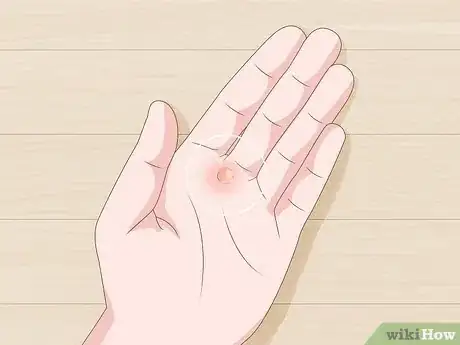
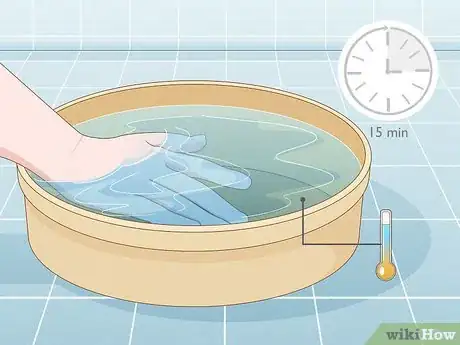


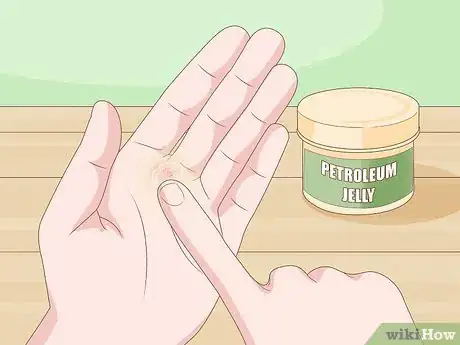
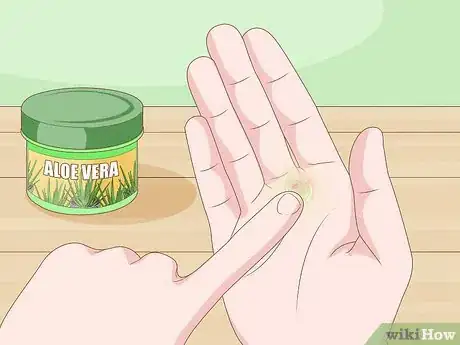
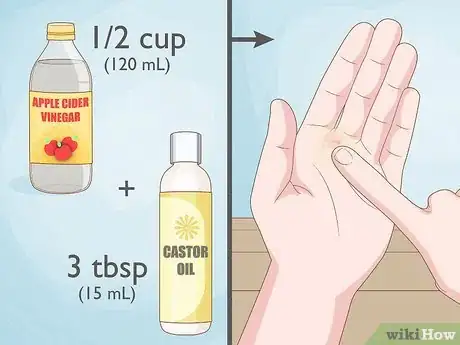

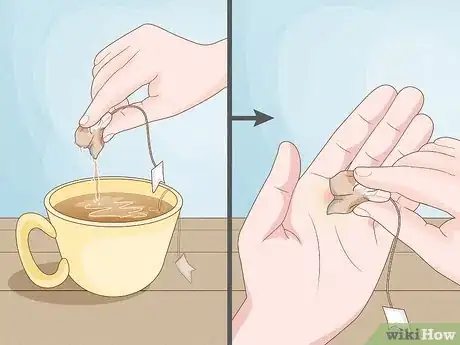




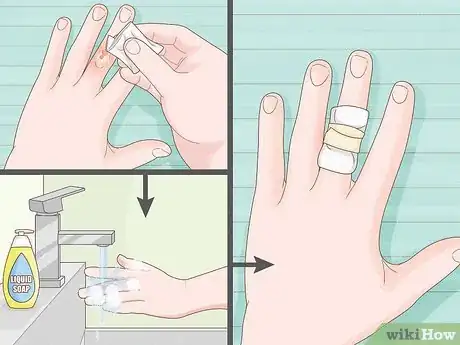
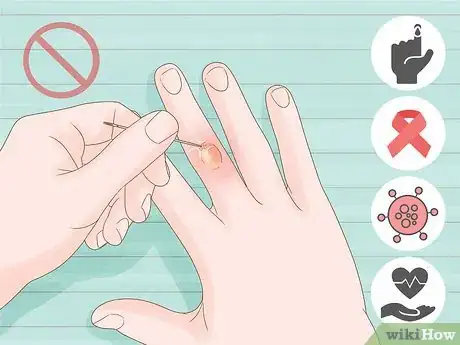
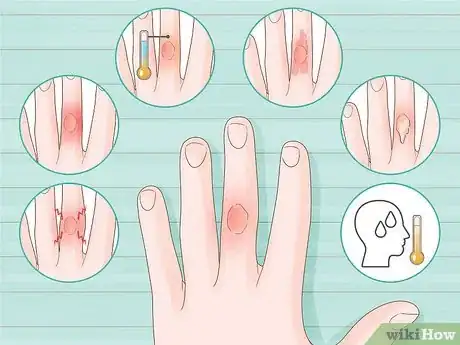





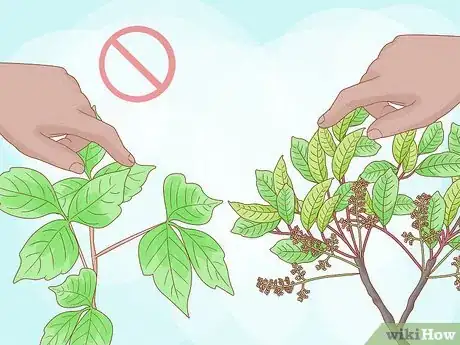

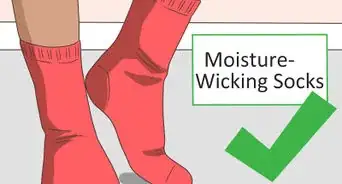
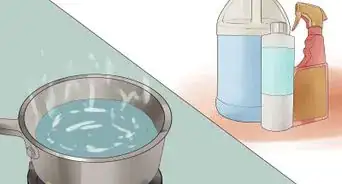
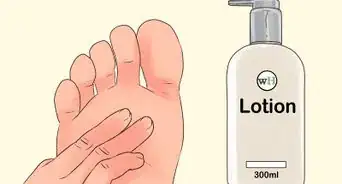




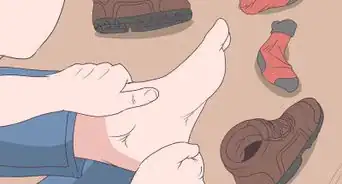
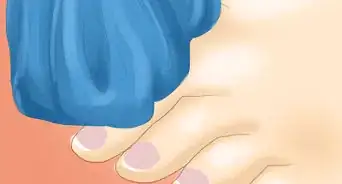

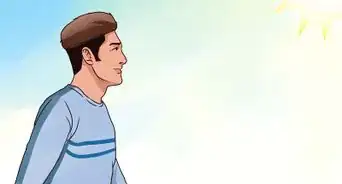















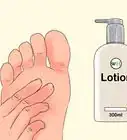



































Medical Disclaimer
The content of this article is not intended to be a substitute for professional medical advice, examination, diagnosis, or treatment. You should always contact your doctor or other qualified healthcare professional before starting, changing, or stopping any kind of health treatment.
Read More...